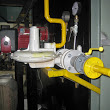Dear Friends IF LPG cylinders are connected in manifold and the quantity exceeds 500 kgs do we require license? What is the applicable rules ? Pl mail Regards and thanks in advance hrk
From India, Madras
From India, Madras
LPG Manifold Safety Requirements
LPG connected in a manifold does not need a license. The shed in which the manifold is kept should have an LPG leak detector, be well-ventilated, have a Fire Hydrant Line with a monitor, and Water Sprinklers. The cylinders should be connected to the manifold at all times. Please check the cylinder expiry months.
Regards,
Sudhir
From India, Vadodara
LPG connected in a manifold does not need a license. The shed in which the manifold is kept should have an LPG leak detector, be well-ventilated, have a Fire Hydrant Line with a monitor, and Water Sprinklers. The cylinders should be connected to the manifold at all times. Please check the cylinder expiry months.
Regards,
Sudhir
From India, Vadodara
Can you let me know which section of the act/rules we should follow for this kind of manifold where all the fire protection requirements are also mentioned? Thanks for your inputs and looking forward to hearing from you.
From India
From India
I remember seeing an amendment to the cylinder rules that stated cylinders connected to the manifold are considered storage and, therefore, will need a license. Unfortunately, I do not have a copy of the notification with me. Earlier, the rule was that cylinders not connected are counted for license requirements.
Regards
From India, Mumbai
Regards
From India, Mumbai
The license to possess LPG cylinders is covered under gas cylinder rules. Under this rule, one can have up to 100 kg without any license. There is no provision that cylinders connected in a manifold do not need any license. No licenses for cylinders connected to the manifold are mentioned only in OSID guidelines, which cannot be treated as legal requirements. For information, please.
Regards,
T.S. SRINIVASAN
From India, Pondicherry
Regards,
T.S. SRINIVASAN
From India, Pondicherry
LPG Industrial/Commercial Installation Guidelines
Please refer to the LPG Industrial/Commercial Installation ISI code of Practice BS 6044 Part 1. The installed capacity of an LPG Manifold Installation should not exceed 1000 kg of LPG. If it surpasses this limit, it should be split. This means having two chambers of LPG Manifolds separately, each comprising the following quantity of cylinders in one manifold. The two rooms should be separated by a brick wall.
1. 19 kg capacity cylinders = 52 cylinders in one manifold (room)
2. 35 kg capacity cylinders = 28 cylinders in one room
3. 47.5 kg capacity cylinders = 21 cylinders in one room
No loose cylinders should be kept; all cylinders should be connected. Please refer to BS 6044 Part 1 & 2 for more details. If the capacity is going to exceed 1000 kg, an "Explosive License" is required along with local approvals. To address this, you can reduce the manifold size by having LoT (Liquid Off-Take) Manifolds with an LP Gas Vaporiser.
For any further information, please post your email.
Thanks and Regards,
Abhinandan
From India, Hubli
Please refer to the LPG Industrial/Commercial Installation ISI code of Practice BS 6044 Part 1. The installed capacity of an LPG Manifold Installation should not exceed 1000 kg of LPG. If it surpasses this limit, it should be split. This means having two chambers of LPG Manifolds separately, each comprising the following quantity of cylinders in one manifold. The two rooms should be separated by a brick wall.
1. 19 kg capacity cylinders = 52 cylinders in one manifold (room)
2. 35 kg capacity cylinders = 28 cylinders in one room
3. 47.5 kg capacity cylinders = 21 cylinders in one room
No loose cylinders should be kept; all cylinders should be connected. Please refer to BS 6044 Part 1 & 2 for more details. If the capacity is going to exceed 1000 kg, an "Explosive License" is required along with local approvals. To address this, you can reduce the manifold size by having LoT (Liquid Off-Take) Manifolds with an LP Gas Vaporiser.
For any further information, please post your email.
Thanks and Regards,
Abhinandan
From India, Hubli
I also checked yesterday. The term used in the cylinder rules of 2004 is "possession," not "storage." Nothing in the rules exempts the manifold. You will need a license if the number of cylinders crosses the limits. For LPG, the limit is 100 kg of gas.
From India, Mumbai
From India, Mumbai
Dear sir pl amil the rule by which the license is required for more tahn 1000kg in manifold regards hrk
From India, Madras
From India, Madras
LPG Cylinder Storage and Licensing Rules
100 kg (equivalent to a maximum of 6 cylinders in terms of cylinder quantity - Domestic 14.2 kg capacity) can be kept at one location unconnected, even though the cylinders are properly sealed and fitted with Derlin Caps. This rule applies to LPGas Distributors and not to anyone else. It implies that when the quantity exceeds 100 kg, a license is required to store or keep them collectively. Apart from LPGas distributors, one family cannot possess more than 2 domestic cylinders (one connected to the stove and another stored as an additional). LPGas Distributors typically do not keep more than 6 filled cylinders at their shop for quick/emergency supply, for which a license is not necessary as they have a licensed godown. Apart from LPGas Distributors, an individual cannot possess an LPGas cylinder (even ONE of any capacity - 5 kg to 47.5 kg) without the proper document called SV.
Manifold Installation and Licensing
Regarding Mr. HRK's case, if the installed capacity of the Manifold exceeds 1000 kg, a license must be issued by The Chief Controller of Explosives, Nagpur. An adequate size of the Manifold Location with fencing and open space all around the installation is required. The rule book is extensive. Therefore, opt for LoT Manifold Installation, which consists of fewer cylinders in one manifold.
Regards,
Abhinandan
From India, Hubli
100 kg (equivalent to a maximum of 6 cylinders in terms of cylinder quantity - Domestic 14.2 kg capacity) can be kept at one location unconnected, even though the cylinders are properly sealed and fitted with Derlin Caps. This rule applies to LPGas Distributors and not to anyone else. It implies that when the quantity exceeds 100 kg, a license is required to store or keep them collectively. Apart from LPGas distributors, one family cannot possess more than 2 domestic cylinders (one connected to the stove and another stored as an additional). LPGas Distributors typically do not keep more than 6 filled cylinders at their shop for quick/emergency supply, for which a license is not necessary as they have a licensed godown. Apart from LPGas Distributors, an individual cannot possess an LPGas cylinder (even ONE of any capacity - 5 kg to 47.5 kg) without the proper document called SV.
Manifold Installation and Licensing
Regarding Mr. HRK's case, if the installed capacity of the Manifold exceeds 1000 kg, a license must be issued by The Chief Controller of Explosives, Nagpur. An adequate size of the Manifold Location with fencing and open space all around the installation is required. The rule book is extensive. Therefore, opt for LoT Manifold Installation, which consists of fewer cylinders in one manifold.
Regards,
Abhinandan
From India, Hubli
Dear Sir, LPG domestic cylinders can not be used in industrial purpose and one can keep only Five cylinders with out license , industrial cylinder capacity is 19 kgs. regards, T.S.SRINIVASAN
From India, Pondicherry
From India, Pondicherry
There are two acts that govern PESO. Cylinder rules fall under the Petroleum Act. The other is the Explosives Act. They are both applicable, not alternate. The cylinder rules state "possession." Nothing there indicates it is only for LPG distributors. Anyone having LPG cylinders in their possession, regardless of whether it's connected or stored, must follow the rules. Additionally, we are discussing commercial gas cylinders in a factory, not domestic cylinders in a home.
From India, Mumbai
From India, Mumbai
The distributor is authorized to have possession and can store at licensed premises. Others can have or be in possession of a legally procured cylinder, either domestic or industrial. However, without a valid document, one cannot have or be in possession of a single cylinder, whether filled or empty. I hope this is clear.
Now, industrial/commercial cylinders are available in 5kg, 19kg, 35kg, and 47.5kg packages (capacity). I am addressing both domestic and industrial aspects of the rules and regulations of the LPG Code of Practice. For all others (excluding gas distributors), possession of cylinders is only permitted with a valid document. Additionally, legally obtained cylinders in industrial cases cannot be stored unconnected or loosely. These cylinders (empty or filled) should be connected to the user line or manifold. I trust this clarifies the matter.
Regards,
Abhinandan
From India, Hubli
Now, industrial/commercial cylinders are available in 5kg, 19kg, 35kg, and 47.5kg packages (capacity). I am addressing both domestic and industrial aspects of the rules and regulations of the LPG Code of Practice. For all others (excluding gas distributors), possession of cylinders is only permitted with a valid document. Additionally, legally obtained cylinders in industrial cases cannot be stored unconnected or loosely. These cylinders (empty or filled) should be connected to the user line or manifold. I trust this clarifies the matter.
Regards,
Abhinandan
From India, Hubli
Without documentation (meaning a license), anyone can have up to 100 kg of LPG in cylinders. That is 5 cylinders in the case of standard 19.5 kg commercial cylinders. Where does it say you cannot have more than 1 cylinder? The point in the original post was about whether he can have 1000 kg in LPG gas cylinders in a manifold. The ISI/BIS rule and norm for setting up a manifold is one aspect. There is also another aspect that is covered under the Explosive Act and Petroleum Act that needs to be adhered to.
From India, Mumbai
From India, Mumbai
The builder in an apartment complex of more than 1000 apartments has built a Reticulated LPG supply system, which has many design faults and no references to the Gas safety rules or IS 6044. The gas bank is a single one with about 3500 kg of gas in several cylinders with a vaporizer at the edge of the multi-story complex. The pipe lengths are quite large, and only a two-stage regulation is used for each apartment. The controls are not easily accessible.
I would like to know what statutory approvals one should have for accepting such a system. Though the quantity of gas is large, the Inspectorate of Explosives is refusing to issue any certificate. How do we accept such a system which has flouted many rules? I am told that the major oil company's certificate is enough, who has done the installation and will supply the gas. Are there any private parties who can do Hazop and safety audit and issue the certificate? Any guidelines?
Regards,
Srini
From India, Bangalore
I would like to know what statutory approvals one should have for accepting such a system. Though the quantity of gas is large, the Inspectorate of Explosives is refusing to issue any certificate. How do we accept such a system which has flouted many rules? I am told that the major oil company's certificate is enough, who has done the installation and will supply the gas. Are there any private parties who can do Hazop and safety audit and issue the certificate? Any guidelines?
Regards,
Srini
From India, Bangalore
Thank you for the input. Additionally, all the fittings used in that location are to be spark-proof.
Thank you for your detailed explanation. As we are not handling LPG, it was not known. This is a nice learning.
Regards.
From India, Delhi
Thank you for your detailed explanation. As we are not handling LPG, it was not known. This is a nice learning.
Regards.
From India, Delhi
If the installed capacity doesn't exceed 1000 kg, then a license from the Explosive Department is not required. However, you need to have in possession a PRESSURE & LEAK TEST REPORT with drawing details layout duly signed to be furnished by the contractor who has carried out the installation. This is very essential.
Ensure proper ventilation at the bottom and at the top of the manifold/storage room. Do not use electric switches or lamps/bulbs in the cylinder premises. You can use concealed bulbs approved by the authority (the contractor knows this) with the switch placed in another location. Please avoid this as much as possible. No mobile phones should be used in the manifold room. Also, no smoking is allowed. Replace the empty cylinders with filled ones by the authorized delivery boy.
Please give a couple of days to solve your query.
Thanks & Warm Regards,
Abhinandan.
From India, Hubli
Ensure proper ventilation at the bottom and at the top of the manifold/storage room. Do not use electric switches or lamps/bulbs in the cylinder premises. You can use concealed bulbs approved by the authority (the contractor knows this) with the switch placed in another location. Please avoid this as much as possible. No mobile phones should be used in the manifold room. Also, no smoking is allowed. Replace the empty cylinders with filled ones by the authorized delivery boy.
Please give a couple of days to solve your query.
Thanks & Warm Regards,
Abhinandan.
From India, Hubli
I would like to add some more critical points regarding the safety of the LPG manifold (LOT):
1. In case more than 1000 kg of LPG installation is there, then the number of installations should not be more than four (including standby).
2. A minimum of 3 meters distance from all sides should be available between the two installations.
3. The vaporizer (other than Direct Heating) should be at least 2 meters away from the LPG manifolds.
4. Only Flameproof (Intrinsically safe) electrical fittings should be installed.
Regards,
Satnam Singh
From India
1. In case more than 1000 kg of LPG installation is there, then the number of installations should not be more than four (including standby).
2. A minimum of 3 meters distance from all sides should be available between the two installations.
3. The vaporizer (other than Direct Heating) should be at least 2 meters away from the LPG manifolds.
4. Only Flameproof (Intrinsically safe) electrical fittings should be installed.
Regards,
Satnam Singh
From India
LPG cylinders connected to Manifold does not required licence it is mentioned in Gas cylinder rules 2016.
CiteHR is an AI-augmented HR knowledge and collaboration platform, enabling HR professionals to solve real-world challenges, validate decisions, and stay ahead through collective intelligence and machine-enhanced guidance. Join Our Platform.





 3
3


